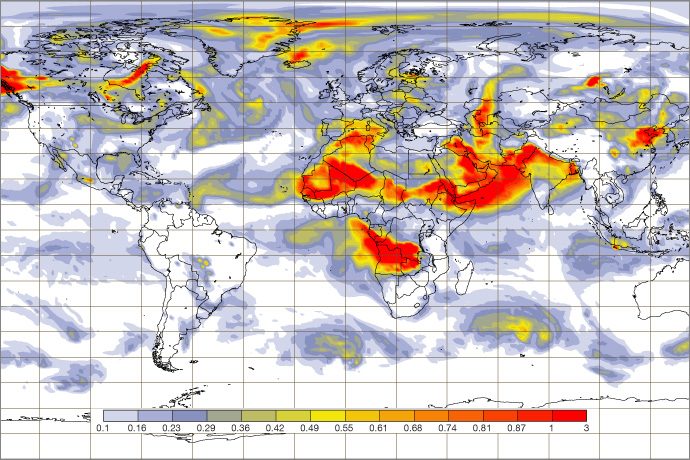

Forecasts produced by the Copernicus Atmosphere Monitoring Service include global aerosol forecasts, as shown in this 4-day forecast of total aerosol optical depth at 550 nm for 00 UTC on 14 July 2019.
The global forecasting system of the Copernicus Atmosphere Monitoring Service (CAMS) was successfully upgraded on 9 July, making air quality forecasts more accurate and robust. CAMS is implemented by ECMWF on behalf of the EU, and the new operational system is based on the latest version of ECMWF’s Integrated Forecasting System (IFS Cycle 46r1).
The upgrade combines three significant scientific and technical changes:
- The number of vertical levels has more than doubled, from 60 to 137. This means that the vertical distribution of atmospheric pollutants, and the meteorological variables (wind, temperature, etc.) that drive the transport of these pollutants, are better represented.
- The number of aerosol species that are used to represent atmospheric aerosol particles has been increased by three to include nitrate and ammonium aerosols. This leads especially to an improvement in the forecasting of particulate matter (PM).
- The latest CAMS emission datasets are now included. Emissions are key drivers of atmospheric pollution and significant progress has been made in improving these datasets.

Example of differences. PM10 concentrations (concentrations of particles less than or equal to 10 μm in diameter, in µg/m3) averaged over March to May 2019 according to the new forecasting system (left) and the old forecasting system (right).
The upgrade also introduces further smaller improvements. Biomass-burning injection heights from the CAMS Global Fire Assimilation System are now used to better describe the height at which most of the gases and particles caused by wildfires are released into the atmosphere. The description of dust emissions and the production of secondary organic aerosols in the forecast model has also been improved.
In addition, the representations of chemical species and aerosols in the forecast model are now more closely connected through the coupling of sulphur dioxide, sulphate and sulphate aerosols. Finally, the representation of chemical species has been improved through updates to the modelling of the wet and dry deposition rates and the chemical reaction rates.

Reduced systematic errors. The chart shows systematic errors (bias, in µg/m3) for the previous version of the forecasting system (red line) and the new version (green line) for forecasts of PM2.5 up to 24 hours ahead against observations from the AirNow network across 907 sites in North America.
The improved global forecasting system was originally launched in January 2019 and ran in test mode for several months before it was made operational. The CAMS validation team, led by the Dutch Weather Service (KNMI), carefully assessed the outputs to ensure the quality of the daily analyses and forecasts. Their report was published in early July and formed the basis for the decision to go ahead with the implementation of this improved version for the benefit of all users.
CAMS forecasts can be accessed directly through the ECMWF data server or through operationally supported FTP access. For any questions, please contact the Copernicus User Support team .
